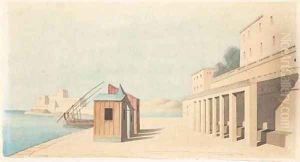Pierre-Francois-Henri Labrouste Paintings
Pierre-François-Henri Labrouste was a prominent French architect renowned for his innovative use of iron and glass in construction, and for his significant contributions to the architecture of libraries. Born on May 11, 1801, in Paris, France, Labrouste was part of a well-educated family and was expected to pursue a career in law. However, his passion for architecture led him to abandon his legal studies and enroll at the École des Beaux-Arts in Paris, where he studied under renowned architects such as Charles Percier and Pierre Fontaine.
Labrouste's skills and dedication to his craft were evident early on when he won the prestigious Prix de Rome in 1824, which allowed him to study at the French Academy in Rome, Villa Medici, for five years. His time in Rome was formative, as he was deeply influenced by the study of ancient architecture and the principles of classicism. Upon his return to Paris, he became a strong advocate for the use of historical research in contemporary architectural practice.
One of Labrouste's most famous works is the Bibliothèque Sainte-Geneviève, completed in 1850. This library is celebrated for its innovative use of a structural iron framework, which is visibly expressed in the building's design. The use of iron allowed for large windows that filled the reading rooms with natural light. His other masterpiece is the reading room of the Bibliothèque Nationale de France, completed in 1868, which is also notable for its iron construction, creating a spacious and well-lit interior.
Labrouste's approach to architecture was both rational and functional, yet he also paid great attention to the aesthetic qualities of his buildings. He believed that modern materials like iron did not need to be hidden away but could be celebrated and integrated into the design, influencing the development of modern architecture.
Throughout his career, Labrouste faced criticism from traditionalists who were skeptical of his use of new materials and technologies. Nevertheless, his work was highly influential to later generations of architects, who recognized the significance of his contributions to the design of public spaces and the integration of new materials and structural methods.
Labrouste died on June 24, 1875, in Fontainebleau, France. His legacy is that of a visionary who bridged the gap between the neoclassical tradition and the beginnings of modern architecture. Today, his innovative use of materials and his dedication to creating functional, yet beautiful public spaces are celebrated by architectural historians and practitioners alike.
